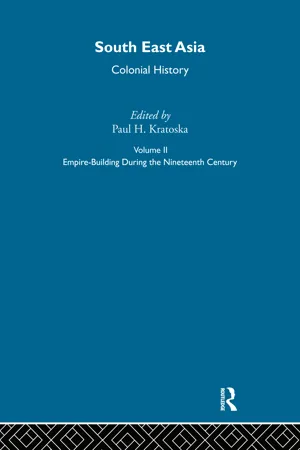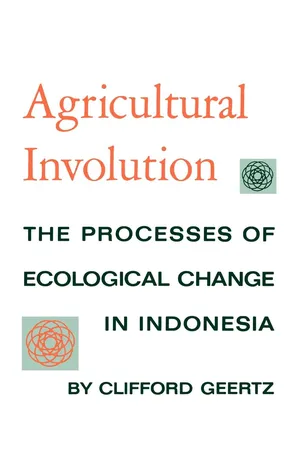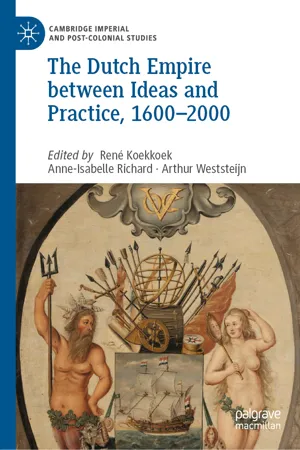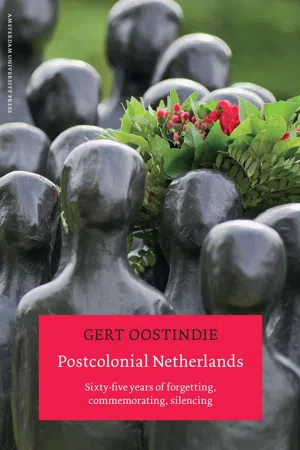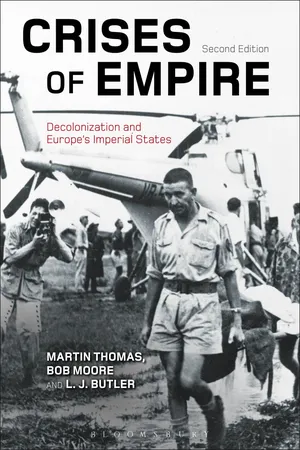History
Dutch Colonization
Dutch colonization refers to the period when the Netherlands established and expanded its overseas territories, particularly in the Americas, Africa, and Asia. This colonization was driven by trade interests, leading to the establishment of trading posts, settlements, and control over valuable resources. The Dutch East India Company played a significant role in this expansion, shaping the economic and political landscape of the regions they colonized.
Written by Perlego with AI-assistance
Related key terms
1 of 5
10 Key excerpts on "Dutch Colonization"
- eBook - ePub
- Paul Kratoska(Author)
- 2021(Publication Date)
- Routledge(Publisher)
Any comparative approach to modern imperialism embracing also the Netherlands is likely to highlight the peculiar and unique position of the Dutch on the spectrum of imperialist performance. It was a small country with a vast colony and it was virtually the only European nation not to partake in the scramble or, for that matter, to acquire any new overseas territories during the period 1870–1914. May we in fact speak of a Dutch imperialism at all at this time? This has indeed become a matter of considerable controversy and it is necessary to review the Dutch historiography on this point before proceeding any further. The first part of this article will demonstrate that the concept of ‘imperialism’ may be profitably applied to the Dutch colonial past.Economic arguments come in many shapes. There is the highly localized instance of the individual pioneer or colonial administrator penetrating virgin territories, thus eventually bringing about formal incorporation and effective occupation. Economic and political, or even psychological, motivations are likely to mingle freely and a better understanding of why conquest took place presupposes that these factors be disentangled on the micro-level of observation. Then there is the more global approach concentrating on structural shifts in the spheres of both economics and politics and extending to longer periods and larger areas. It will be argued here that we can fully appreciate the momentum of overseas expansion only by accounting also for its macro-economic framework. In short, expansion implied both that vested interests were being built up on the spot and that the emerging colonial state possessed an economic foundation of its own. The second and third parts of this article will survey the micro and macro aspects of Dutch imperialist expansion in Indonesia respectively.On Dutch imperialism
Contemporary Dutch reaction to other nations’ imperialism was often one of disgust and moral condemnation. What the French did in Indochina, let alone the British in South Africa, was something fundamentally different from the reluctant assumption by the Dutch of their responsibilities towards the indigenous peoples of the Indonesian archipelago. The exclusive concentration on existing possessions and the ethical undertones of colonial policy as it was pursued from 1900 onwards combined to make the Dutch conduct overseas deviate so markedly from the general norm at the time of modern imperialism. This axiom dominated the Dutch historiography on the recent colonial past throughout the traumas of decolonization and even beyond. It was only seriously challenged after 1970. Since then two lines of thought have been developed, one preserving the tradition of Dutch uniqueness in colonial history and the other stressing the similarities with other imperialist nations. - No longer available |Learn more
- (Author)
- 2014(Publication Date)
- The English Press(Publisher)
________________________ WORLD TECHNOLOGIES ________________________ Chapter-3 Colonization of the Americas Dutch Colonization of the Americas Dutch trading posts and plantations in the Americas precede the much wider known colonisation activities of the Dutch in Asia. Whereas the first Dutch fort in Asia was built in 1600 (in present-day Indonesia), the first forts and settlements on the Essequibo river in Guyana and on the Amazon date from the 1590's. Actual colonization, with Dutch settling in the new lands, was not as common as with other European nations. Many of the Dutch settlements were lost or abandoned by the end of that century, but the Netherlands managed to retain possession of Suriname until it gained independence in 1975, as well as the Netherlands Antilles and Aruba, which remain within the Kingdom of the Netherlands today. ________________________ WORLD TECHNOLOGIES ________________________ North America 1685 reprint of a 1656 map of the Dutch North American colonies showing extent of Dutch claims, from Chesapeake Bay and the Susquehanna River in the South and West, to Narragansett Bay and the Providence-Blackstone Rivers in the East, to the St. Lawrence River in the North In 1602, the government of the Republic of the Seven United Netherlands chartered the Dutch East India Company ( Vereenigde Oostindische Compagnie ), or VOC with the mission of exploring it for a passage to the Indies and claiming any uncharted areas for the United Provinces, which led to several significant expeditions. The two Dutch settlements in the Americas are, New Netherlands and New Amsterdam. In 1609, the VOC commissioned English explorer Henry Hudson who, in an attempt to find the so-called northwest passage to the Indies, discovered and claimed for the VOC parts of the present-day United States and Canada. In the belief that it was the best route to explore, Hudson entered the Upper New York Bay sailing up the Hudson River which now bears his name. - eBook - PDF
- Steven Drakeley(Author)
- 2005(Publication Date)
- Greenwood(Publisher)
With the conclusion of this last wave of conquest, the colony of the Netherlands Indies reached its final territorial extent around 1910. The process was partly driven by particular motives of com- mercial opportunity (coal in Kalimantan, pepper and oil in Aceh, tin in Bangka) and partly by the desire to end various annoyances that the remaining local independent states posed to Dutch inter- ests, such as providing havens for pirates and "smugglers." In the case of Bali, for instance, the Dutch were irritated by Balinese undercutting of the colonial state's opium-monopoly prices and their habit of looting the occasional Dutch ship that wrecked on the Balinese coast. Renewed fears of rival colonial interlopers also provided a strong motivation to clearly establish the boundaries of Dutch interests. This was the period of a renewed competitive scramble among the European colonial powers, recently joined by the United States, to expand their colonial boundaries, if only to prevent potential rivals from stealing a march. THE CULTIVATION SYSTEM The Cultivation System was based on a simple piece of self- serving colonialist reasoning. Each Javanese village was held to owe the state a land tax (a Raffles innovation), payable in cash, but hitherto never collected in a consistent fashion. Each village was compelled to set aside a proportion of its land and provide the necessary labor to grow suitable export crops, a proportion sufficient upon sale to cover its tax bill. In theory, the village could 40 The History of Indonesia keep any extra cash if it overproduced but had to make up the dif- ference if it underproduced. The colonial government paid a fixed price for the export products, such as coffee and sugar, ensuring a healthy margin of profit when they were sold to the world. The beauty of this mechanism for wealth extraction can be fully appre- ciated when it is recalled that the money paid out to the villages for the products came back to the government as taxes. - eBook - ePub
Agricultural Involution
The Processes of Ecological Change in Indonesia
- Clifford Geertz(Author)
- 2023(Publication Date)
- University of California Press(Publisher)
The Netherlands was never able, particularly after William Fs attempt to re-absorb Belgium failed, to develop a manufacture export economy even remotely comparable to that of Britain, and so the interest of the Dutch in Indonesia remained overwhelmingly mercantilist to the end. The stimulation in Indonesia of extensive markets for industrial goods, it was feared, would lead only to increased British (or, later, Japanese) influence; the essential economic task was to maintain a decent differential between the import and re-export prices of East Indian agricultural products— a task which implied the developing of Dutch commercial institutions and the discouraging of Indonesian ones. 1 Amid the apparent fluctuations of policy, the colonial period consists, from the economic point of view, of one long attempt to bring Indonesia’s crops into the modern world, but not her people. The means for accomplishing this effort to keep the natives native and yet get them to produce for world markets was the formation of a chronically, and in fact intrinsically, unbalanced economic structure sometimes referred to as “dual.” 2 In the export sector, there was administrative capitalism: a system in which the holders of capital, the Dutch, regulated selling prices and wages, controlled output, and even dictated the processes of production. In the domestic sector there was family-unit agriculture, a little home industry, and some petty internal trade. As the first expanded, stimulated by rising world commodity prices, the second contracted; land and labor were taken out of rice and other village staples and put into sugar, indigo, coffee, tobacco, and other commercial crops - René Koekkoek, Anne-Isabelle Richard, Arthur Weststeijn, René Koekkoek, Anne-Isabelle Richard, Arthur Weststeijn(Authors)
- 2019(Publication Date)
- Palgrave Macmillan(Publisher)
On the one hand, there is a perception of a reluctant, commerce -based, culturally respectful form of Dutch colonialism, on the other hand is the grim image of ruthless and permanent violence, coercive labour and racism. Both flavours have always lived side by side. The question is: under what circumstances could such disparate perceptions develop? Evidently other European empires have generated similar kinds of skewed imaginaries—actually they are an essential feature of Western imperialism over the last centuries. But several ingredients of Dutch imperialism and politics left their mark on the intellectual home colonial cultures in The Netherlands or Dutch Republic. Empire was the biggest public secret of the Netherlands, and it continues to be so. The fact that most if not all surveys of Dutch history largely ignore the imperial roots of Dutch politics and culture, demonstrates how uneasily colonialism fits into the Dutch national autobiography. 1 Empire—the use of the term was always carefully avoided in Dutch parlance—was something that happened ‘over there’; it was administered from the Netherlands in a business-like and efficient manner. In many ways, colonial cultures in the Netherlands were dramatically unspectacular. This helped to conceal the praxis of empire from home. What almost without exception appeared to the Dutch onlooker as, first, a world of trade and reluctant conquest and, much later, a specimen of rational developmentalism, in reality operated as belligerent and violent regimes. 2 Dutch imperialism may have been unobtrusive or shrouded, but its practices were never ‘normal’. Slave trade, forced labour and coercive exchange were acquired tastes and needed justification. This was provided by stakeholders, lawyers, policymakers, intellectuals and artists- eBook - PDF
Postcolonial Netherlands
Sixty-Five Years of Forgetting, Commemorating, Silencing
- Gert Oostindie, Michael Bommes, Lena Tsipouri, Vanja Stenius, Michael Bommes, Lena Tsipouri, Vanja Stenius(Authors)
- 2012(Publication Date)
- Amsterdam University Press(Publisher)
‘SOMETHING MAGNIFICENT WAS DONE THERE!’ With the collapse of the Dutch Republic at the end of the eighteenth century, the companies also disappeared from the stage. Around 1815 the United Kingdom of the Netherlands took over the management of the colonies. It was not long before the East Indies became economically, politically, scien-tifically and culturally crucial to the metropole. At the same time, hope evaporated of making profitable colonies of Suriname and the Antilles. They disappeared from view and did not return into focus until after the East Indies had been lost and particularly with the Caribbean exodus to the Netherlands. If the colonial system had been unashamedly directed towards the inter-ests of the metropole, at the end of the nineteenth century its course, in the-ory, shifted. The Netherlands, in the words of C.T. van Deventer, had a ‘debt of honour’ to pay. 14 Put more positively, the new ‘ethical politics’ saw as its task the elevation of the natives and bringing economic development to the colony. The planned modernization process coincided with the – where nec-essary – violent pacification of the archipelago, which was more or less com-pleted by about 1910. More than a hundred years after first contact and settle-ments, the Dutch finally controlled the entire archipelago, although this colonial hegemony was only to last three decades. The Dutch East Indies were in all respects heterogeneous, with arbitrary borders and a fragile con-figuration that were direct consequences of a colonial history that might have turned out very differently. Dutch interest in the East Indies is often reduced to the frequently in-voked contemporary metaphors of the ‘cork’ that kept the Dutch economy afloat and the worry that without its Asian colony, the Netherlands would 136 POSTCOLON I A L N ET H ER L A N DS plunge to the ‘rank’ of smaller European countries such as Denmark. - eBook - PDF
Indonesian Postcolonial Theatre
Spectral Genealogies and Absent Faces
- Evan Darwin Winet(Author)
- 2010(Publication Date)
- Palgrave Macmillan(Publisher)
Though nationalists would later speak of ‘350 years of Dutch colonial- ism,’ the first two centuries after the founding of Batavia saw only mod- est, strategic territorial expansion. By the end of the century, the English had relinquished their claims on most of the islands (including the trade of the nutmeg-rich island of Run for Manhattan at the Treaty of Breda in 1667). With their defeat of the last major rival fort at Makassar in 1669, the VOC consolidated their control of the spice trade. In 1682, Ranamanggala granted the VOC exclusive trading rights through Banten, effectively expel- ling the English East India Company from operation in Java. 6 The soaring profits of the Company turned Amsterdam into the financial capitol of Europe, and little could have been gained through territorial expansion beyond the port garrisons. By the mid-eighteenth century, however, the Company’s fortunes turned permanently for the worse (and London began to supplant Amsterdam’s financial pre-eminence). The spice trade stag- nated, epidemics decimated the colonial population and corruption sapped the Company’s profits. In 1796, the Netherlands, newly reconstituted as a Napoleonic ‘Batavian Republic,’ nationalized the Company. On 1 January 1800, the Company charter expired and was not renewed. For the first time, Dutch holdings in the Indies officially became colonies of the Netherlands, albeit a Netherlands that was itself once again somewhat less than sovereign in relation to Napoleonic France. The ‘truly colonial period of Javanese history’ (Ricklefs, 2001: 155) lasted barely over a century and was preceded and followed by brief, but consequential Introduction: Colonial Foundations and Precessions of Postcoloniality 15 interregnums of other empires. In 1811, British forces took control of Java in the course of engaging France in the colonial maritime theatre, and returned the colony to the Dutch in 1816. - eBook - ePub
Colonial Exploitation and Economic Development
The Belgian Congo and the Netherlands Indies Compared
- Ewout Frankema, Frans Buelens(Authors)
- 2013(Publication Date)
- Routledge(Publisher)
2 Colonial extraction in the Indonesian archipelago
A long historical view
Thee Kian Wie2.1 Introduction1
This chapter assesses the history of Dutch colonial extraction in the Indonesian archipelago in a long-term perspective. The gradually increasing intensity of Dutch involvement in the indigenous economies and polities since the late sixteenth century highlights one of the key distinctions from the extension of Belgian domination over the Congo, which evolved in a much shorter period of time. The chapter starts with a discussion of the bilateral monopoly that the Dutch East India Company (Vereenigde Oost-indische Compagnie, henceforth VOC) obtained on the spice trade in the Moluccas in the early seventeenth century. The VOC's control of the spice trade took the form of a monopsony on the purchase of spices cultivated by the local population and a monopoly on the sale of these spices in the Dutch Republic. The chapter then addresses the change in extractive institutions during the expansion of state rule under the Netherlands Indies government after the Napoleonic wars, focusing on the development of the infamous Cultivation System (Cultuurstelsel, CS) in Java (1830–70) and the debate concerning the welfare effects of the CS.The chapter then goes on to discuss the abolition of the CS and the liberal reforms introduced in the 1870s, highlighting the emergence of alternative means of colonial extraction in the form of a penal sanction (a specific form of later coercion) imposed on the indentured workers recruited by the plantations in East Sumatra in the second half of the nineteenth century. The Ethical Policy launched by the Netherlands Indies government in the first decade of the twentieth century can be considered as a first attempt to use public policy instruments to raise the welfare of broad layers of the Indonesian population, but it will be argued that this shift in the approach of the Dutch was partial and not sustained. Finally, the chapter briefly delves into the extractive policies imposed by the Japanese military authorities to support Japan's war effort during its occupation of the Netherlands Indies (March 1942 to mid-August 1945), namely forcibly acquiring food and manpower from the Indonesian population. - eBook - PDF
Crises of Empire
Decolonization and Europe's Imperial States
- Martin Thomas, Bob Moore, Larry Butler(Authors)
- 2015(Publication Date)
- Bloomsbury Academic(Publisher)
Instead, a series of steps were taken during and after the war to ‘modernize’ the Netherlands’ constitutional relationship with her remaining imperial territories after the loss of Indonesia, most notably the three Round Table conferences of 1948, 1952, and 1958. More important in the post-war period were the internal political developments that went hand in hand with this modernization – the emergence of political parties based on ethnic divisions and the extension of the franchise to include most of the adult population for the first time. However, even in the 1960s, it could be argued that the political structure of the colony militated against support for increased independence, and it was ultimately only the conjuncture of a particular set of internal political circumstances combined with a sea change in Dutch attitudes towards empire in the early 1970s which brought full independence. 1 The effects of the Second World War The defeat and occupation of the European Netherlands had brought new social and economic pressures to the West Indian colonies. In the summer of 1940, there were rumours of German Crises of Empire 294 troops ready to invade the Guianas from Brazil and the chairman of the US War Resources Board, Edward R. Stettinius, voiced fears about the security of bauxite shipments. With the cessation of colonial trade with the motherland, it was estimated that some 80 per cent of Suriname’s imports now came from the United States, and even the Governor was forced to admit ‘the greatly increased dependence on the US’. 2 Anglo-American observers evinced a fairly low opinion of Dutch colonial administration in general and the Governor in particular. Anti-colonialist sentiment was to be expected from the Americans, but even the British, who were more sympathetic to the plight of a weakened colonial power, saw the regime as inefficient and inadequate to the task of defending the colony effectively. - eBook - ePub
How the West Came to Rule
The Geopolitical Origins of Capitalism
- Alexander Anievas, Kerem Nişancıoğlu(Authors)
- 2015(Publication Date)
- Pluto Press(Publisher)
In the first section, we show that by the turn of the 17th century, the Dutch ruling class was suffering from a crisis in the relatively low supply of the single most important commodity in the capitalist mode of production: labour-power. In the second section, we then examine how the Dutch ruling class, unlike the Venetians and Genoese who preceded them, were able to solve this crisis through the accumulation, subordination and bringing together of a vast amount of capital and labour-power on a global scale. This involved a combination of New World surpluses with coerced labour in Asia. It took place through the historically specific experience of Dutch colonialism as an encounter – a moment of combination – between the Dutch East India Company (VOC) and various Asian societies in the Indian Ocean littoral. We argue that were it not for this moment of combination, and were it not for the Dutch drawing on an extensive – albeit dispersed – mass of labour-power in Asia, Holland’s capitalist development would have been unsustainable in the ways other antediluvian forms were. We then argue in the third section that the emergence of capitalism as a mode of production – as a wider set of practices that enable the reproduction of the capital–wage-labour relation – was necessarily dependent on, and built upon, the exploitation of ‘unfree’ labour. In fact, the vast quantities of unfree or unwaged labour exploited in Asia were the foundations on which the freedom of waged-labour in the Dutch Republic was built.The Specificity and Limits of Dutch CapitalismDutch Institutional InnovationsWhy the Dutch and not the Italian city-states? In his magisterial The Long Twentieth Century, Giovanni Arrighi argues that the Dutch represented a break from not only prior instances of capital, but also the feudal structure of power in Europe more broadly. According to Arrighi, the Dutch were the first to ‘be presented with, and seize, the opportunity to transform the European system of rule to suit the requirements of the accumulation of capital on a world scale’.34 As such, they entered into conflict with feudal powers, and simultaneously came to be seen as champions of new dynastic rulers seeking to break from the hold of the Habsburg Empire and Papacy,35 leading to a broader sociopolitical transformation of the European states system. For Arrighi, this transformation found its clearest expression in the Thirty Years’ War and the subsequent conclusion of hostilities with the 1648 Treaty of Westphalia. The concomitant treaties pertaining to the freedom of the seas (and therefore trade) further indicate the reordering of the European states system in line with the requirements of capital accumulation on an expanded scale of operation. In these ways, Dutch policies aimed at transforming the European geopolitical order in the service of extended capital accumulation over the 17th century represented the kind of ‘hegemonic agency’ (albeit limited and partial) conceived by various neo-Gramscian scholars36
Index pages curate the most relevant extracts from our library of academic textbooks. They’ve been created using an in-house natural language model (NLM), each adding context and meaning to key research topics.
